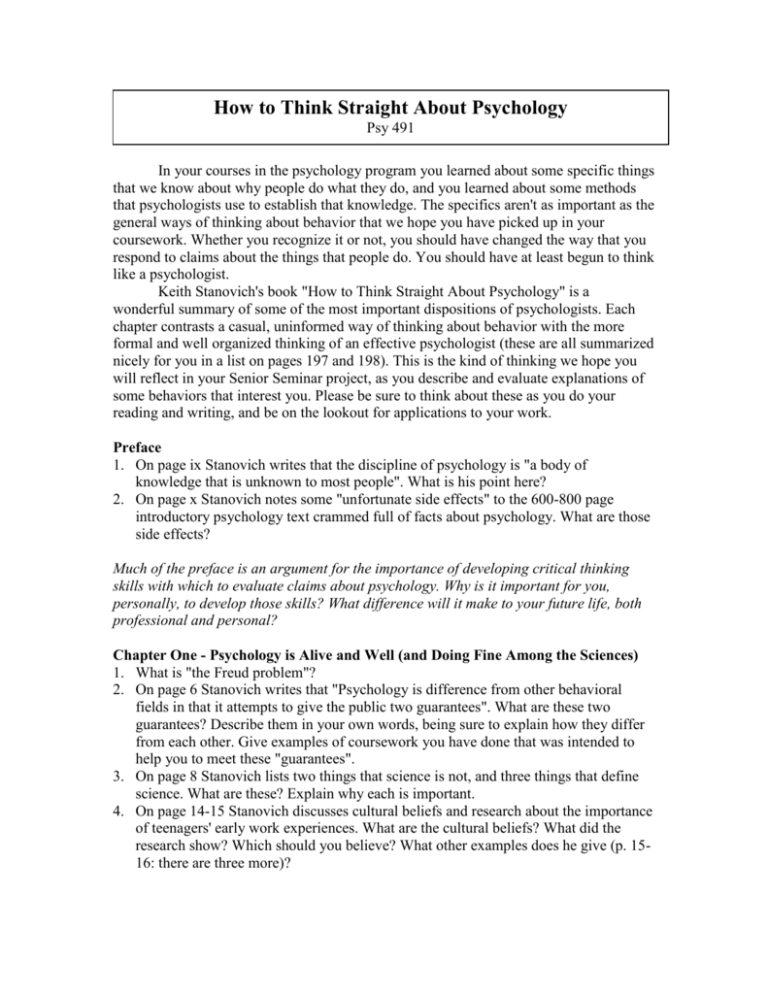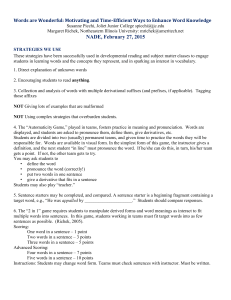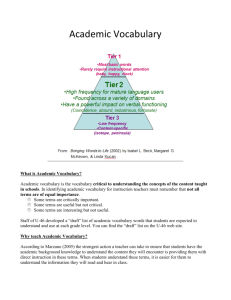In your courses in the psychology program you learned about some
advertisement

How to Think Straight About Psychology Psy 491 In your courses in the psychology program you learned about some specific things that we know about why people do what they do, and you learned about some methods that psychologists use to establish that knowledge. The specifics aren't as important as the general ways of thinking about behavior that we hope you have picked up in your coursework. Whether you recognize it or not, you should have changed the way that you respond to claims about the things that people do. You should have at least begun to think like a psychologist. Keith Stanovich's book "How to Think Straight About Psychology" is a wonderful summary of some of the most important dispositions of psychologists. Each chapter contrasts a casual, uninformed way of thinking about behavior with the more formal and well organized thinking of an effective psychologist (these are all summarized nicely for you in a list on pages 197 and 198). This is the kind of thinking we hope you will reflect in your Senior Seminar project, as you describe and evaluate explanations of some behaviors that interest you. Please be sure to think about these as you do your reading and writing, and be on the lookout for applications to your work. Preface 1. On page ix Stanovich writes that the discipline of psychology is "a body of knowledge that is unknown to most people". What is his point here? 2. On page x Stanovich notes some "unfortunate side effects" to the 600-800 page introductory psychology text crammed full of facts about psychology. What are those side effects? Much of the preface is an argument for the importance of developing critical thinking skills with which to evaluate claims about psychology. Why is it important for you, personally, to develop those skills? What difference will it make to your future life, both professional and personal? Chapter One - Psychology is Alive and Well (and Doing Fine Among the Sciences) 1. What is "the Freud problem"? 2. On page 6 Stanovich writes that "Psychology is difference from other behavioral fields in that it attempts to give the public two guarantees". What are these two guarantees? Describe them in your own words, being sure to explain how they differ from each other. Give examples of coursework you have done that was intended to help you to meet these "guarantees". 3. On page 8 Stanovich lists two things that science is not, and three things that define science. What are these? Explain why each is important. 4. On page 14-15 Stanovich discusses cultural beliefs and research about the importance of teenagers' early work experiences. What are the cultural beliefs? What did the research show? Which should you believe? What other examples does he give (p. 1516: there are three more)? In this chapter, Stanovich argues for a psychology supported by scientific research. How do you suppose you might find yourself using results of specific psychological research in your future life, again, both professional and personal? Chapter Two - Falsifiability 1. On page 19 Stanovich tells a story about the reasoning of Doctor Benjamin Rush, who used bloodletting to treat yellow fever. In your own words, what was Rush's belief, and what were the evidence and reasoning that he used to support it? 2. What is the falsifiability criterion? (p. 20). 3. On page 21 Stanovich talks about a "theory of knocking rhythms". What is the point of that story? 4. On page 25 Stanovich talks about scientists having become impatient with ESP research, and notes that "one reason is undoubtedly that the area is tainted by fraud, charlatanism, and media exploitation". Why should that "taint" a scientific hypothesis? Why would a history of fraud with respect to a claim make scientists less likely to pay attention to that claim in the future? 5. On page 28 Stanovich writes that "in science, making a mistake is not a sin". How can it be okay to make a mistake in science? What kind of mistake is he talking about? This chapter was all about going out on a limb. Tell me about something that you believe, and something that you might do to show that your belief is false. Chapter 3 - Operationism and Essentialism 1. Stanovich (p. 35) says that science does not "attempt to answer 'ultimate' questions about the universe". What makes a question an "ultimate question"? Give an example of such a question (not one of those in the book). 2. What is operationism? Give an example in psychology (not one of those in the book). What is the target of operationism? (that is, what is it that is operationalized?) 3. What is the "pre-existing bias problem" in psychology (p. 40)? 4. On the bottom of page 42 and onto page 43, Stanovich talks about "Operationism as a Humanizing Force". Explain his argument, using your own words. Suppose you wanted to know what psychologists mean when they use the term "patience". How would you go about finding out? Chapter 4 - Testimonials and Case Study Evidence 1. On page 52 Stanovich says that many popular therapies are backed by nothing but testimonials of people who have used them, and he says that "case studies and testimonials are virtually worthless as evidence". Why are they virtually worthless? 2. Later on that same page he says that case studies do have some value. What is it that he thinks case studies are good for, and how does that differ from the purposes for which he finds them "virtually worthless"? (see also the example near the top of page 57). 3. On page 53 Stanovich points out that there are plenty of people who honestly believe that subliminal self-help tapes have improved their memory or self-esteem, but that controlled studies show that these tapes do not improve memory or self-esteem. Why should we believe the studies and not the testimonials? (your response should discuss alternative explanations). 4. Pages 54-55 talk about two important alternative explanations for the apparent success of treatments (medical and/or psychological). What are they? 5. What is "the vividness problem"? (p. 57) How does it apply to testimonials? On page 60 Stanovich describes a study by Wilson and Brekke (1994). Describe this study in your own words, including the reference in APA format. Chapter 5 - Correlation and Causation 1. The "toaster/birth control" and pellegra stories at the beginning of the chapter are intended to demonstrate a shortcoming of correlational evidence. What is it that Stanovich says correlation evidence cannot demonstrate? What kind of study does he say provides better evidence in those situations? 2. When is correlational evidence enough? 3. On page 73 Stanovich describes a statistical study that concluded that "after variables reflecting the students' home backgrounds and general mental ability were factored out, there was virturally no relationship between school achievement and the type of school attended". What conclusion does he draw from that about the value of public versus private schooling? Quite a bit of the end of this chapter is about conservatives' misuse of correlations to argue that spending more money on schools does not improve them. Earlier material in the chapter defended public schools against conservatives' claims that private schools work better. The examples given seem to show that conservatives' arguments tend to be based on bad reasoning. Is this because conservatives reason more poorly than the rest of us, or is it because we choose examples in order to make conservatives look bad (that is, a selection bias of our own)? How would you tell? Chapter 6 - Getting Things Under Control 1. On page 84 Stanovich talks about the drawback of a study in which the participants themselves select the group they are in. Why is this a problem? 2. On page 85 Stanovich talks about three types of research study applied to the question of whether or not portacaval shunts were an effective treatment for cirrhosis of the liver. How did those types of research differ? What is the point Stanovich is making here? On page 83 Stanovich explains "control" very clearly. Find the paragraph in which he does this, and put it into your own words. Chapter 7 - "But It's Not Real Life!" 1. On pages 101 and following Stanovich talks about Douglas Mook's explanation of the kinds of research goals in which random samples are important and those in which such samples are not important. When is a random sample important, according to Mook? 2. What is the "College Sophomore Problem" (p. 108)? How does Stanovich feel about it? The entire point of this chapter is that artificial "laboratory" situations are better than natural situations if the goal is to "yield explanations about the nature of the world" (p. 99). How can that be? Chapter 8 - Avoiding the Einstein Syndrome 1. This entire chapter is about two competing beliefs about science. What are those beliefs? Which does Stanovich want us to hold? 2. What does Stanovich think is the reason why so many people hold the wrong belief about this? 3. What is the "connectivity principle"? What is the "gradual synthesis model"? What is "converging evidence"? 4. On page 126, Stanovich talks about "the progression to more powerful methods". Describe this progression? What kinds of methods do researchers use first? What kinds do they use later? On page 124 Stanovich talks about a situation in which psychologists presented expert testimony in a trial in which a rock group was accused of driving two boys to suicide. In your own words, explain what happened with the expert testimony in that trial, and how the researcher (Timothy Moore) feels about the outcome. Chapter 9 - The Misguided Search for the "Magic Bullet" 1. At the end of the first paragraph in this chapter, Stanovich writes "Behavior is multiply determined". What does he mean? 2. On page 132 Stanovich talks about the concept of "interaction". What does this refer to? In your project, you will identify some possible causes for some behavior. How will you apply the points of this chapter to the way that you think and write about your topic? Chapter 10 - The Achilles' Heel of Human Cognition 1. On page 139 Stanovich uses the term "probabilistic trend". What is that? What is the opposite (that is, what kind of "trend" would NOT be "probabilistic")? 2. On page 140 Stanovich says that virtually all of what we know about psychology is probabilistic. Why? Why aren't psychological laws stated in terms of certainties? 3. What are "person-who" statistics? What kind of argument uses "person-who" statistics? What's wrong with that kind of argument? Describe a situation in which you might be asked to make a diagnostic judgment. What personal experiences might cause you to judge poorly? Chapter 11 - The Role of Chance in Psychology 1. What is "the tendency to try to explain chance events"? Give an example. 2. Why do we have this tendency? 3. On page 154 Stanovich says that "when we say that something is due to chance, we do not necessarily mean that it is indeterminate, only that it is currently indeterminable". What is the difference? 4. On page 166, Stanovich contrasts clinical and actuarial predictions. What are these? What does he say about them? These comments about clinical prediction may be shocking. It's probably safe to say that most people who go into clinical practice do so believing that they will have the ability to use personal information to diagnose mental health problems. What does Stanovich's claim about clinical prediction say about clinical practice? Chapter 12 - The Rodney Dangerfield of the Sciences 1. On pages 176 through 178 Stanovich lists three kinds of books that are typically found in the "Psychology" sections of bookstores. What are these? 2. On page 176 Stanovich says that parapsychology (ESP, etc.) is not an area of research in modern psychology. Why (according to Stanovich) isn't it? 3. On pages 181 through 184, Stanovich points out that when psychologists are interviewed by the media, one kind of comment gets published, and another kind never does. What are these two kinds of comments? Beginning on page 186, Stanovich talks about the ways that psychologists themselves contribute to the disrespect given to the field of psychology. Then on page 188, he says that various forms of clinical training do not lead to improved therapeutic outcomes for mental health patients. Assuming that you are hoping to work in some form of psychotherapy, how can you - personally - reconcile this with your goals and the training required to reach them? Course Goals 1. You will reflect on your past work in psychology in order to identify your interests, strengths, and areas to be developed further. The first task in this class will be to do a portfolio review of your prior work in psychology, with a goal of using selfunderstanding to improve your work on the current project. 2. You will choose an appropriate topic. While the choice of topic is fairly wide open, there are some limitations. You will need to explain something about the behavior, thoughts, or emotions of people or animals, and you will need to do so at a psychological level (that is, addressing individuals as individuals). 3. You will use two psychological theories to explain behaviors, thoughts, or emotions. This means that you will need to demonstrate that you understand how those theories explain things in general, and apply those theories to the specific topic that you have chosen. 4. You will critically evaluate those theoretical explanations. This may be new ground for you, as in the past you were probably simply asked to understand how theories explained certain behaviors, thoughts, or emotions. In this class we will talk about how to evaluate those theoretical explanations, and you will do some evaluation in both your paper and your presentation. 5. You will find and use appropriate psychological literature. While you may use some "popular press" sources as well, your paper will be grounded mainly in the psychological academic literature. Obviously you can't find everything written on your topic, but you will demonstrate that you can find and use appropriate sources to support your points. Your sources will support both your understanding of theories and your claims about your specific topic. 6. You will act and interact in professional ways in the classroom. This will include engaging in classroom discussion with peers as well as the instructor, asking relevant questions, and assisting peers with resources and ideas. 7. You will use APA format (Publication Manual, 5th edition, 2001) in your final paper.






